Begonia Illumination - description, cultivation, application
Begonia is grown among tropical plants in the garden and at home. There are so many plant species that they amaze with a variety of shapes and sizes. And in the design of the garden, premises, the flower is always used. There are evergreen specimens that are decorative due to the color of the leaves. Ampelous tuberous begonias are in full bloom.
Among ampelous species of begonias Illumination can be distinguished. The plant has many buds during flowering. From them, beautiful flowers appear with double petals, cascading down thin stems.
Content:
- Description and best varieties
- Begonia breeding methods
- Planting a plant
- Care Tips
- Possible growing problems
- Diseases, their signs, treatment
- Pests, fighting them
- Application of Illumination begonia in design
Description and best varieties
There are several varieties of this type of begonia:
| Variety name | Description |
| Illumination white | Ampel begonia with a tuberous root system. Shoots are long, thin, covered with medium-sized leaves. Covered with snow-white double-type flowers from May to October. |
| Illumination apricot | The hybrid has flowers with a fringe of petals of a solar color: apricot, yellow, cream. The petals are decorated with red stripes along the main field. |
| Illumination Non-stop apricot | The variety blooms constantly. Cascading begonia pleases with a dense flow of apricot color. |
| Illumination Champagne | Begonia is distinguished by a pronounced aroma of light yellow flowers. |
All Illumination begonias are considered the finest tuberous plants. They will decorate the premises and the summer cottage.
Begonia breeding methods
Tuberous begonias reproduce in several ways:
- Begonia is rarely propagated by seeds, but this method allows you to preserve parental qualities in the "children". But the breeding process is quite laborious. The small seeds of the plant must be mixed with earth or river sand before planting. The seeds are not buried in the ground, but laid out on the surface, pressing down on top with glass or film.
- Begonia is planted by cuttings in autumn or spring. In order for them to take root better, they are placed in a nutritious soil, watering regularly. Rooting can be done in water. The stalk is placed in a vase of water at room temperature, adding a tablet of activated carbon.
- The division of bulbs, or tubers, is carried out in begonias of three years of age.
- You can divide the tubers into parts so that each has a kidney. The place of division is sprinkled with wood ash powder, dried. It remains to place the cuttings in the ground, filling only half of the tuber. After the roots appear, pour the soil into the pot.
The method of reproduction by tubers and cuttings is suitable for the rejuvenation of begonia, because it begins to bloom poorly after 5 years of life.
Video on how to plant tuberous begonia:
Planting a plant
It is better to plant begonia with tubers that have not yet sprouted. The optimal planting time will be mid-March - early April. Then, after 3 months, begonia will begin to bloom.
Begonia always germinates successfully if the planting is carried out on time and correctly.
Before planting, tubers are rejected, disinfected in a solution of potassium permanganate. In a pot with a diameter of 10-12 centimeters, soil is poured, consisting of two parts of leafy earth, one part of humus and sand. Having placed a tuber or part of it with a bud in the nutrient soil, do not forget to leave most of the planting material on the surface.
The tuber notch should point upwards. Cover with foil from above and put in a warm place. It is necessary to constantly ventilate and moisturize the tuber. When watering, it is necessary to watch that water does not fall on the tuber. As soon as sprouts appear, remove the film, and add soil to the pot.
Care Tips
Begonias Illumination needs competent care:
- Water the plant sparingly so that the roots do not rot from excess moisture. Moderation is especially important during the flowering period of an ornamental culture.
- It is necessary to feed the plant in spring and autumn with complexes with phosphorus and potassium.
- It is better to keep the ampelous begonia out of direct sunlight.
- During the dormant period, the flower does not need special care. It needs a temperature within 15 degrees Celsius, and watering and feeding is less than during the growing season.
Despite minimal maintenance, begonia will give the beauty and splendor of flowering.
Possible growing problems
If begonia does not bloom, then problems may have arisen due to improper care:
- With excessive soil moisture, the leaves will begin to dry out, and the buds will not open and fall off. The hardness of the water negatively affects the condition of the plant. Bright sunlight, overheating of the plant leads to a lack of flowers on the shoots.
- The plant needs a constant supply of fresh air and a temperature in the range of 20-25 degrees Celsius. But drafts, sharp jumps in temperature, poor lighting lead to falling buds. During the cold summer, begonia leaves begin to curl. And a lack or excess of fertilizers will cause the plant to stop developing.
- The foliage begins to turn yellow when the soil in the pot is compacted, the air is dry. And begonia will not bloom in such conditions.
- If begonia grows in the garden, then the tubers are dug up, dried and stored in the basement. It is impossible for the tubers to freeze or rot. Therefore, it is necessary to monitor the air temperature and humidity in the room where the bulbs are stored.
In order for the begonia to come out of dormancy well and bloom, it is necessary not to dry the bulb, loosen the soil in the pot.
More information about begonia diseases can be found in the video:
Begonia diseases, their signs, treatment
| Name of the disease | Signs | Treatment |
| Powdery mildew | The entire ground part is covered with white blooms, then turns brown and dies. | Carry out measures to dry the soil, ventilate the room. After removing the infected leaves and inflorescences, spray the begonia bush with Fundazol. During the flowering of the plant, it is better to use a solution of colloidal sulfur in 0.5%. |
| Blackleg | The root part of the shoots turns black, the leaves fall off. | Sprayed with Karbofos or others fungicidal agents. |
| Root rot | Yellowish spots appear on the leaves, after which they turn black. | Transplanted into another container by treating the tubers. |
| Spotting | The surface of the leaves is covered with small watery spots, which grow into a continuous field. | At the first sign, the begonia is transplanted into another pot, having treated the soil and container with a solution of potassium permanganate. With an advanced stage of the disease, the flower is destroyed. |
| Gray mold | All parts of the plant are covered with a grayish fluffy bloom containing fungal spores. | Plant processing Bordeaux liquid concentration in 1% or a solution of copper sulfate (2 grams per liter of water) with laundry soap (20 grams). When the disease spreads, fungicides actively act: Fundazol, Topsin. |
Begonia diseases arise from improper care, inappropriate conditions for the growth of Illumination begonia.
Pests, fighting them
| Pest | What harm does | Control methods |
| Nematodes | Parasites lead to tissue necrosis of the root system. Oppressing the plant, they contribute to deformation of the stems, their cracking. | In case of severe nematode infestation, the plants are destroyed. |
| Spider mite | It sucks the juices from the plant, preventing it from developing, blooming. You can find it by the thin cobwebs on the back of the leaves. | An infusion of potato tops is effective against parasites, to which green or laundry soap is added for better adhesion. |
| Aphid | Feeding on plant juices, aphid colonies lead to deformation and curling of leaves. And the sticky secretions of the parasite attract spores of the soot fungus to begonia. | The leaves are washed with a solution of laundry soap, the begonia is sprayed with Aktellik-type insecticides. |
| Thrips | Sucking insects can be found by brown spots at the bottom of the leaf, and a silvery bloom at the top. | When insects appear, they are treated with an infusion of dandelion leaves or potato tops. In case of severe infection, insecticides will help. |
Application of Illumination begonia in design
Tuberous species of begonias will become a real decoration of the house, veranda in summer. Vases with hanging cascades of flowers are placed in front of the entrance to the house, terrace.
They can be used to decorate shady gazebos and recreation areas.
If the plant is planted in the garden, then it is used to arrange borders. Illumination goes well with lobelia, iberis, lobularia, ornamental shrubs.
Begonia blooms for a long time, until October, so it is often used by designers to decorate the garden and premises.



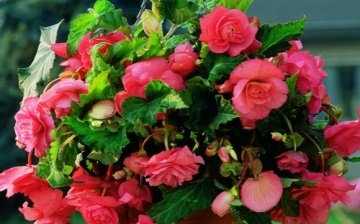
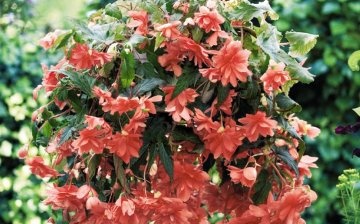
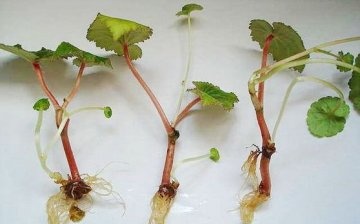
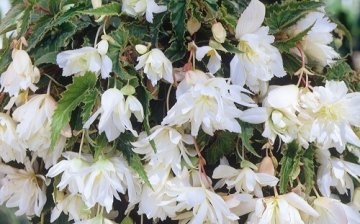
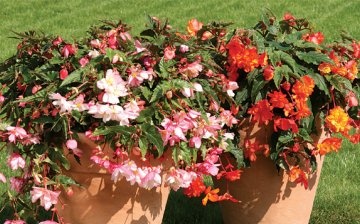

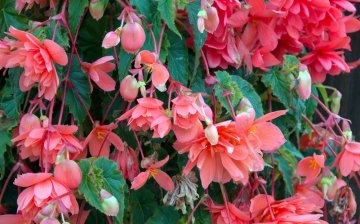










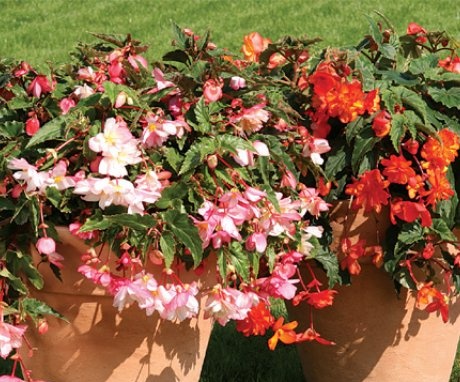
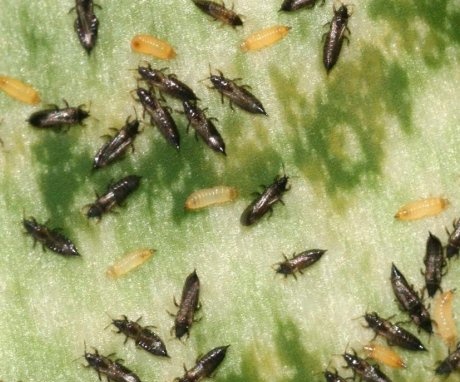
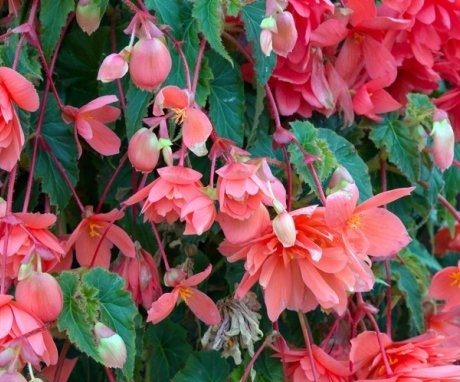
I just love begonias. I have a lot of them. But over time, the tubers become old and the plant does not bloom well. Thanks to your article, I learned how to rejuvenate them and successfully applied them on my flowers.